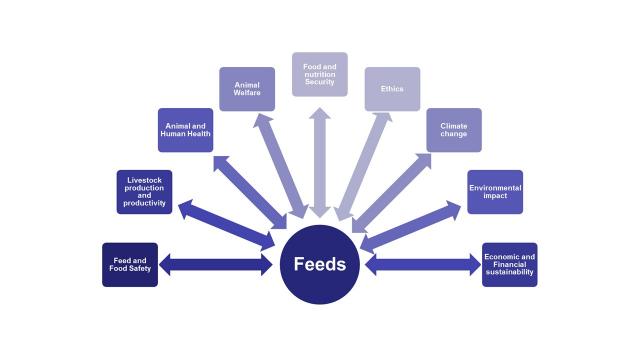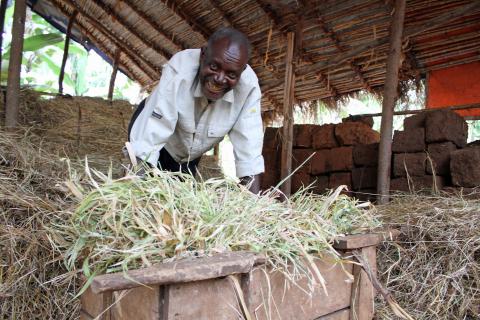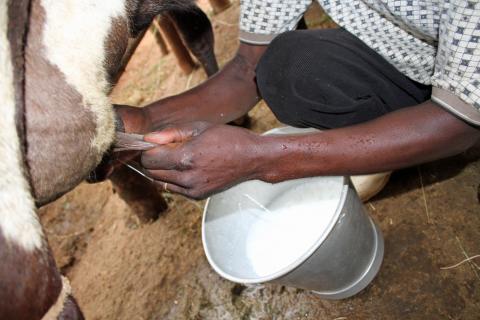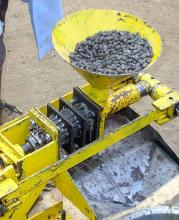Animal nutrition: beyond the boundaries of feed and feeding
By Harinder P.S. Makkar
Food and Agriculture Organization of the United Nations, Animal Production and Health Division, Rome, Italy
Introduction
In a conventional sense Animal Nutrition is the science of feed preparation and feeding i.e. how feeds should be prepared and fed to animals to produce adequate and safe food and non-food materials such as wool or manure. Availability, in a sustained manner, of desired type and quantity of animal feed and its feeding is the foundation of livestock production system. Animal feed availability and animal feeding is a multi-faceted theme. It influences all livestock sub-sectors across production systems. It also has far reaching effects on human nutrition, poverty, food prices and global economy. It impacts almost every sector of the livestock production – from animal reproduction, health and welfare – to farm economic viability, environment, animal product safety and quality.
Over the last 25 years, considerable progress has been made in increasing our understanding of the metabolism in domestic animals, at levels of biological organization, including the whole animal, organ systems, tissues, cells, and molecules. Although the birth of ‘molecular biology’ including ‘omics’ offers exciting opportunities in better understanding the fundamental nutrition, the strategic and applied research in future will focus on better understanding of interactions and dynamics amongst how feed is prepared and fed, animal nutrition and other components such as environment, welfare, biodiversity, product quality and safety
Traditionally, the issues of environment, animal health, animal welfare, product safety and quality have been debated separately for each domain. In this short paper, efforts have been made to weave strands from these domains with animal nutrition and overall sustainability of the livestock operation. This will enable better appreciation of the role of feed and feeding in livestock operation. Also synergies and trade-offs of managing various domains can be established in more integrated and more meaningful ways (Makkar, 2016).
Animal nutrition and productivity
Poor feeding decreases productivity of the animal. A vast array of literature on nutrition-reproduction interactions shows that good feeding increases milk production of lactating animals. It also increases growth rate of meat producing animals, giving more meat. Good nutrition increases reproductive efficiency: higher cyclicity, lower age at first calving, lower inter-calving interval, higher productive life and higher profitability to farmers (FAO/IAEA, 2002). Furthermore, now a good body of evidence exists showing that in utero nutrition has impact on productivity and health of offsprings later in life (Bell and Greenwood, 2013, 2016).
Animal nutrition and farm economics
Feed is financially the single most important element of animal production, irrespective of species and production system. Feed cost can account for up to 70% of the total cost of production of an animal product. High feed costs can wipe out a livestock rearing operation. In 2008, high cost of feeds decreased supply of animal products and increased prices. Optimization of feed use efficiency i.e. producing more with less feed decreases feeding costs and increases economic viability of the livestock operation (Makkar and Beever, 2013).
Animal nutrition and product safety and quality
The safety and quality of the food chain can be affected because of the close link between feed and food-borne pathogens such as Escherichia coli, Salmonella and Campylobacter. These pathogens can get into animal products through animal feed. Mycotoxins, heavy metal, radionuclides, pesticides, dioxin, dibenzofurans, and other toxins present in feed get transferred into animal products affecting animal and human health and product safety. Animal feed safety impacts on animal health, welfare and productivity as well as safety of the human food supply and the livelihood of farmers (FAO 2012b). Microbial species such as Salmonella enterica that are pathogenic for humans are also found in fresh food plants (Franz et al., 2008a). Further, survival of these pathogenic bacteria in soil was also found to be affected by how manure is managed (Franz et al., 2008b) and the composition of the diet fed to cattle that produced the manure (Franz et al., 2005). Safe feed helps to reduce production costs, maintains or increases food quality and reduces feed and food losses and wastes. Contaminated feed has often resulted in food of animal origin being recalled and/or destroyed with significant economic losses for the livestock industries and a negative impact on food security. Feed is an integral part of the food chain, feed production must therefore be subject, in a similar manner as food production, to the quality assurance of integrated food safety systems.
A large body of literature, for example, (Butler, 2014; Vazirigohar et al., 2014) presents opportunities to improve final product quality through manipulation of animal feeding (e.g. increases in: conjugated linoleic acid, 3-omega fatty acids, minerals in animal products, product shelf life). Many of these changes elicit positive effects on human health. Recently, there has been interest in the use of dietary polyunsaturated fatty acids (PUFA), specifically the omega-3 (n-3) fatty acids (FA) α-linolenic acid (ALA), eicosapentaenoic acid (EPA), and docosahexaenoic acid (DHA) to improve sow and piglet performance. Feeding specific n-6 and n-3 FA from either fish (Mateo et al., 2009; Leonard et al., 2010) or flax (Farmer and Petit, 2009) to sows also transfer these fatty acids to their offspring via milk. Feeding cattle with flax-based feeds can increase concentrations of n-3 fatty acids in beef (Drouillard et al., 2004).
Animal nutrition and environment
The livestock production is resource demanding: it occupies 30% of the world’s ice-free surface and consumes 8% of global human water use, mainly for the irrigation of feed crops (FAO, 2009a). The area dedicated to feed-crop production represents 33% of total arable land. In addition, animal products generally have a much higher water and carbon footprints than plant-based foods (Mekonnen and Hoekstra, 2012; Ripple et al., 2014) and livestock sector contributes approximately 14.5% of all anthropogenic greenhouse gas (GHG) emissions (7.1 Gigatonnes of CO2-equivalent per year). Globally, the production, processing and transport of feed account for about 45% of the GHG emission from livestock sector. At a species level, feed production constitutes 47% and 57% of emissions from pork and chicken supply chains, respectively. For cattle, small ruminants and buffalo, feed production contributes 36%, 36% and 28% of the total emissions respectively (Gerber et al., 2013). Feed nutrients (70 to 90% of nitrogen and phosphorus) are lost into the environment through manure, which if not managed properly can lead to environmental pollution. Livestock contribute 37% of anthropogenic CH4, mostly from enteric CH4 (FAO, 2009a), which is largely feed dependent. Feed production and use also impact land use and land use change (Gerber et al., 2013), which also leads to loss of sequestered carbon and biodiversity. Both environment and biodiversity degradation have linkage with ecosystem and human health. Smart feeding practices, especially the balanced ration approach i.e. feeding a diet containing nutrients such as protein, carbohydrates and minerals in the right proportion and in an amount that meets the nutrient requirements of animals for achieving the targeted production would decrease nitrogen, phosphorus and methane release in the environment and the biodiversity loss (FAO, 2012a; Garg et al., 2013). Use of locally adapted feed resources is also expected to conserve biodiversity.

Animal nutrition and food-feed competition
In 2012–2013, 795 million tonnes of cereals (one-third of total cereal production) were used in animal feed and by 2050 an additional 520 million tonnes would be required for feeding livestock. In 2000, 78% of feed grains were fed to pigs and poultry in regions where industrial intensive system dominate (FAO, 2013a). In the last 20 years, there has been an increased interest in forage-fed beef for multiple reasons (health related, environmental concerns, and welfare issues) (Scaglia et al., 2014). Use of smart feeding options such as decrease in the level of grains in the concentrate by using agro-industrial by-products, increase in green fodder use, feeding of total mixed ration instead of feeding individual ingredients, use of chopped forages, increase in digestibility of crop residues could contribute to decrease in grain in diet.
Animal nutrition and feed-fuel competition
About 10% (ca 120 million ones) of global production of course grains are used for bioethanol production (FAO, 2013a). A continued rapid expansion of biofuel production up to 2050 would lead to the number of undernourished pre-school children in Africa and South Asia being 3 and 1.7 million higher than would have been otherwise the case (FAO, 2009b). Efficient use of alternate novel feed resources such as biofuel coproducts e.g. glycerol, dried distillers grains, gluten meal, cassava residue, Camelina sativa meal, sweet sorghum residue, kernel meal from the non-toxic Jatropha, pongamia meal, castor meal, palm kernel meal, and algae residue (Makkar, 2013) would contribute to decreasing feed-fuel competition.
Animal nutrition and animal health
Improper nutrition (unbalanced diet, under or over feeding) impacts health adversely directly, and also makes animals more prone to diseases. Furthermore, in case of disease, corrective measures in the form of medicines are less or not effective. Vaccination done during the period of improper nutrition might also properly protect the animals. Correct nutrition can reduce infectious afflictions by enhancing cell-tissue integrity and optimizing defence mechanisms of the immune system (FAO, 2012b). Feeding of balanced ration has been shown to increase immuno-globulin levels in blood, suggesting higher immunity (FAO, 2012a). Supplements such as minerals, antioxidants and amino acids such as methionine also play a role in immune stimulation (Jankowski et al., 2014; Celi et al., 2014). Good nutrition is also a biosecurity measure to control zoonotic and infectious diseases.
Animal nutrition and animal welfare
Feeding to sustain high production levels, nutrient deficiency or excess can lead to metabolic disorders in ruminants such as acidosis and lameness causing welfare issues; whilst breeding animals of monogastric species which are restrict-fed to optimise health and production may suffer from chronic hunger. A number of welfare problems in ruminants are elicited by the feeding of poor quality or unsafe feeds. A properly balanced diet free of undesirable substances and water supplied in adequate amounts avoid physical and psychological suffering from hunger and thirst; furthermore correct nutrition is crucial for optimal performance and to sustain optimal fitness. Further information on adverse effects of improper animal nutrition on animal welfare and the corrective measures is available in FAO (2012b).
Animal nutrition and global security
Increased food-feed-fuel competition can lead to food shortages, high food price and high volatility in prices. This could adversely impact global food security and could possibly trigger civil unrest and conflict among masses and between people and government. Government stability and governance could be affected, resulting on global insecurity. This has happened in the recent past in some developing counties. Animal nutritionists have a role as a peacemaker also by playing with the feeds and feeding in a manner that there is least food-feed-fuel competition and the feed efficiency is optimized to achieve more animal products from less feed.
The choice of feed constituents (diet) and their consumption affect animal productivity (including reproductive efficiency), greenhouse gas emissions (GHG), animal health, animal-sourced food safety and quality and animal welfare. The production of those dietary constituents has an impact on water quality, GHG and land use. The animal well-being and possibly human well-being may be influenced by animal diets.
The aforesaid challenges and issues are being addressed through the FAO’s initiative: Towards Sustainable Animal Diet. A Sustainable Animal Diet may be defined as the diet that has the core traits, i.e. balanced in all nutrients, free from deleterious components, meet production objective, generate animal products that are safe for human consumption and integrates the Three-P dimensions of sustainability (Planet, People and Profit; inter alia, have been used to describe the term, implying ecological soundness, social equity and economic growth) and also the ethical dimension (Makkar and Ankers, 2014). Translating the Sustainable Animal Diet Framework into action would be beneficial for the animal, the environment and the society, and is likely to generate socio-economic benefits (FAO, 2014); and animal nutritionists have a vital role in achieving this. Animal nutritionists put in place strategies that increase nutrient use efficiency in animal food chain i.e. enhance transfer of nutrients from feed to animal products. These strategies simultaneously decrease nutrient excretion into the environment, which assist in controlling pollution. Furthermore the strategies also enhance animal health, welfare and production. Examination of undesirable constituents in feed, integrated with sound quality control systems (FAO, 2013b), also contribute in enhancing animal product safety and preventing feed wastage. All these efforts fall in the domain of animal nutritionists.
In the changing scenarios – achieving high production is not only sufficient – high animal productivity, animal product safety and quality, animal welfare and health and protection of environment and biodiversity are also being increasingly demanded. Increasing awareness and emphasis on animal welfare, environment, product safety and quality have become a priority in food production systems involving animals. In this changing landscape animal nutritionists should consider themselves fortunate because they could influence most of the activities of the livestock Sector. Animal nutritionists are at the cross-roads where almost all sectors and services of the livestock industry meet. They are in the driver’s seat for taking the livestock sector towards sustained development following the principles of the Sustainable Animal Diet. Substantial contribution can be made by animal nutritionists in: producing adequate, safe and nutritious food in a humane way in the face of rapid population growth; saving the environment, biodiversity and the way of life of pastoralists and ranchers; bringing smallholder livestock farmers out of poverty; promoting industrial growth, alleviating malnutrition especially in pregnant ladies and growing children that is related to inadequate vitamins, minerals and amino acids consumption; safeguarding public goods including human health; and promoting global security.
References
Bell, A.W. and Paul L. 2013. Greenwood Optimizing maternal cow, grower and finisher performance in beef production systems. In: Optimization of feed use efficiency in ruminant production systems. Proceedings of the FAO Symposium, 27 November 2012, Bangkok, Thailand. FAO Animal Production and Health Proceedings, No. 16. Rome, FAO and Asian-Australasian Association of Animal Production Societies (available at: http://www.fao.org/docrep/018/i3331e/i3331e.pdf).
Bell, A.W. and Paul L. 2016. Nutrition during gestation influences postnatal productivity of ruminant livestock. Broadening Horizons 30, Feedipedia (available at: http://www.feedipedia.org/content/nutrition-during-gestation-influences-postnatal-productivity-ruminant-livestock).
Butler, G. 2014. Manipulating dietary PUFA in animal feed: implications for human health, Proc. Nutr. Soc. 73: 87–95.
Celi, P., Chauhan, S.S., Cottrell, J.J, Dunshea, F.R., Lean, I.J., Leury, B.J. and Liu, F. Oxidative stress in ruminants: enhancing productivity through antioxidant supplementation (available at: http://www.feedipedia.org/content/oxidative-stress-ruminants-enhancing-productivity-through-antioxidant-supplementation).
Drouillard, J. S., M. A. Seyfert, E. J. Good, E. R. Loe, B. Depenbusch, and R. Daubert. 2004. Flaxseed for finishing beef cattle: Effects on animal performance, carcass quality, and meat composition. In: Proc. 60th Flax Institute, March 17-19, Fargo, ND. p. 108–117.
FAO. 2009a. The State of Food and Agriculture: Livestock in the Balance, FAO Rome (available at: http://www.fao.org/docrep/012/i0680e/i0680e.pdf).
FAO. 2009b. How to Feed the World in 2050, Rome (available at: http://www.fao.org/fileadmin/templates/wsfs/docs/expert_paper/How_to_Feed_the_World_in_2050.pdf).
FAO. 2012a. Balanced feeding for improving livestock productivity – Increase in milk production and nutrient use efficiency and decrease in methane emission, by M.R. Garg. FAO Animal Production and Health Paper No. 173. Rome (available at: http://www.fao.org/docrep/016/i3014e/i3014e00.pdf).
FAO. 2012b. Impact of animal nutrition on animal welfare – Expert Consultation 26−30 September 2011 – FAO Headquarters, Rome, Italy. Animal Production and Health Report. No. 1. Rome (available at: http://www.fao.org/docrep/017/i3148e/i3148e00.pdf).
FAO. 2013a. Food outlook (available at: http://www.fao.org/docrep/018/al999e/al999e.pdf).
FAO. 2013b. Quality assurance for microbiology in feed analysis laboratories. Animal Production and Health Manual 16, Rome (available at: http://www.fao.org/docrep/018/i3287e/i3287e.pdf).
FAO. 2014. Towards a concept of Sustainable Animal Diets, by Harinder P. S. Makkar & Philippe Ankers. FAO Animal Production and Health Report. No. 7. Rome (available at: http://www.fao.org/3/a-i4146e.pdf).
FAO/IAEA. 2002. Development and field evaluation of animal feed supplementation packages. IAEA TECDOC 1294, IAEA, Vienna, Austria (available at: http://www-naweb.iaea.org/nafa/aph/public/iaea-tecdoc-1294.pdf).
Farmer, C. and H. V. Petit. 2009. Effects of dietary supplementation with different forms of flax in late-gestation and lactation on fatty acid profiles in sows and their piglets. J. Anim. Sci. 87:2600–2613.
Franz E and Van Bruggen AHC. 2008a. Ecology of E. coli O157:H7 and Salmonella enterica in the primary vegetable production chain. Crit Rev Microbiol 34:143–161.
Franz E, Semenov AV, Termorshuizen AJ, de Vos OJ, Bokhorst JG and van Bruggen AHC.2008b. Manure-amended soil characteristics affecting the survival of E. coli O157:H7 in 36 Dutch soils. Environ Microbiol 10:313–327.
Franz E, van Diepeningen AD, de Vos OJ and van Bruggen AHC. 2005. Effects of cattle feeding regimen and soil management type on the fate of Escherichia coli O157:H7 and Salmonella enterica serovar Typhimurium in manure, manure-amended soil, and lettuce. Appl EnvironMicrobiol 71:6165–6174.
Garg, M.R., Sherasia, P.L., Bhanderi, B.M., Phondba, B.T., Shelke, S.K. and Makkar, H.P.S. 2013. Effects of feeding nutritionally balanced rations on animal productivity, feed conversion efficiency, feed nitrogen use efficiency, rumen microbial protein supply, parasitic load, immunity and enteric methane emissions of milking animals under field conditions. Animal Feed Science and Technology 179: 24–35.
Gerber, P.J., Steinfeld, H., Henderson, B., Mottet, A., Opio, C., Dijkman, J., Falcucci, A. and Tempio, G. 2013. Tackling climate change through livestock – A global assessment of emissions and mitigation opportunities. Food and Agriculture Organization of the United Nations (FAO), Rome (available at: http://www.fao.org/docrep/018/i3437e/i3437e.pdf).
Jankowski, J., Kubińska, M. and Zduńczyk, Z. 2014. Nutritional and immunomodulatory function of methionine in poultry diets - A review. Annals of Animal Science 14: 17–31.
Leonard, S. G., T. Sweeney, B. Bahar, B. P. Lynch, and J. V. O’Doherty. 2010. Effect of maternal fish oil and seaweed extract supplementation on colostrum and milk composition, humoral immune response, and performance of suckled piglets. J. Anim. Sci. 88:2988–2997.
Makkar, H.P.S. 2013. Biofuel co-products as animal feed. FAO, Rome.(available at: http://www.fao.org/docrep/016/i3009e/i3009e.pdf).
Makkar, H.P.S. 2016. Animal nutrition in a 360-degree view and a framework for future R&D work: towards sustainable livestock production. Anim. Prod. Sci. – Perspectives on Animal Biosciences http://dx.doi.org/10.1071/AN15265
Makkar, H.P.S. and Beever, D. 2013. Optimization of feed use efficiency in ruminant production systems. Proceedings of the FAO Symposium, 27 November 2012, Bangkok, Thailand. FAO Animal Production and Health Proceedings, No. 16. Rome, FAO and Asian-Australasian Association of Animal Production Societies (available at: http://www.fao.org/docrep/018/i3331e/i3331e.pdf).
Makkar H.P.S. and Ankers, P. 2014: Towards sustainable animal diets: A survey-based study. Animal Feed Science and Technology 198: 309–322.
Mekonnen, M.M. and Hoekstra, A.Y. (2012). A Global Assessment of the Water Footprint of Farm Animal Products. Ecosystems 15: 401–415.
Mateo, R. D., J. A. Carroll, Y. Hyun, S. Smith and S. W. Kim. 2009. Effect of dietary supplementation of n-3 fatty acids and elevated concentrations of dietary protein on the performance of sows. J. Anim. Sci. 87:948–959.
Ripple, W.J., Smith, P., Haberl, H., Montzka, S.A., McAlpine, C. and Boucher, D.H. (2014). Ruminants, climate change and climate policy. Nature Climate Change 4: 2–4.
Scaglia, G., J. Rodriguez, J. Gillespie, B. Bhandari, J. J. Wang and K. W. McMillin. 2014. Performance and economic analyses of year-round forage systems for forage-fed beef production in the Gulf Coast. doi:10.2527/jas.2014-7838
Journal of Animal Science 2014 92:5704-5715.
Vazirigohar, M., Dehghan-Banadaky, M., Rezayazdi, K., Krizsan, S.J., Nejati-Javaremi, A. and Shingfield, K.J. 2014. Fat source and dietary forage-to-concentrate ratio influences milk fatty-acid composition in lactating cows. Animal. 8(1):163–74.
Photo credits
Stéphanie Maylon, CIAT, CC-BY-SA-2.0; Henning, R. K., Wikimedia Commons, CC-BY-SA- 2.5




